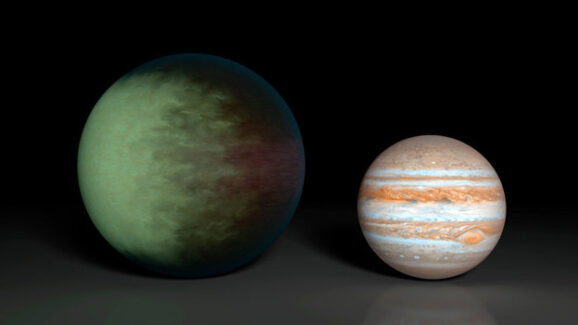Scientists Spot Clouds On An Exoplanet
This article is more than 2 years old

Kepler-7b was, as I’m sure you’ve guessed, discovered by the Kepler telescope back when it was fully operational and in the business of spotting “candidate” planets. In fact, it was one of the first five planets identified, though it wasn’t confirmed until 2009. Like other candidate planets, Kepler-7b orbits a star, though one much larger and hotter than ours, and is often referred to as a “hot Jupiter.” This means that it shares characteristics with the giant planet, but is far hotter due to its closer proximity to its sta. 7b is also much bigger than Jupiter.
A couple years ago, scientists noted that Kepler 7-b is particularly reflective. Most hot Jupiter planets aren’t, as their high temperatures tends to cause the re-absorption of light in the infrared. Jupiter itself has an albedo—that’s the measure of a planet’s reflectivity, 1 being the highest and 0 being the lowest—of .5 because of the ice and ammonia in the atmosphere. But most hot Jupiter planets have albedos of .3 or less—except Kepler, which has an albedo of .42. This was the first clue that there’s something a bit different was going on in its atmosphere.
Further observations have revealed that Kepler-7b has phases, like those of the moon, as well as a consistently bright spot in its western hemisphere. The Spitzer Space Telescope calculated 7b’s temperature to be somewhere between 1,500-1,800 degrees Fahrenheit, which, while a little steamy for us, is actually far cooler than scientists expected, given planet’s proximity to its parent star. Instead of being absorbed, clouds in the planet’s western hemisphere were reflecting some of the star’s light. Scientists have also learned that the clouds don’t change or move much, and that the planet appears to have a surprisingly stable climate.
Kepler-7b is approximately 1,000 light-years away from Earth, so we need to keep working on those interstellar travel possibilities before we can take advantage of its livability. Still, this is the first time scientists have observed clouds on an exoplanet, and where there are clouds, there are weather systems at least familiar to us Earthlings. The more we study clouds on other planets, the more we can understand how their climates work, and what conditions may or may not favor human—or alien—life.












